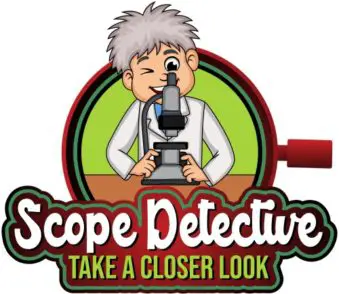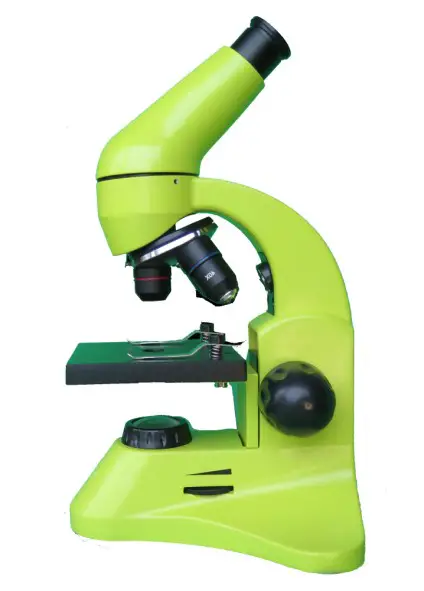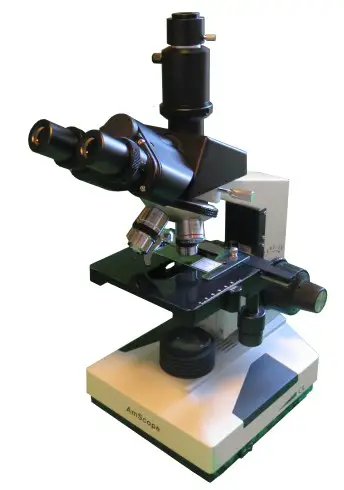 About this Article: Hi, I’m Chris – a teacher and a lover of microscopes! On this site I share beginner microscopy activities for kids and students. Legal note: This information does not constitute professional advice to you and your circumstances or guarantee quality or fit for purpose of the following products. Use of this website is governed by our Disclaimer, Terms and Conditions and Privacy Policy posted in the footer of this website. As an Amazon associate I earn from qualifying purchases.
About this Article: Hi, I’m Chris – a teacher and a lover of microscopes! On this site I share beginner microscopy activities for kids and students. Legal note: This information does not constitute professional advice to you and your circumstances or guarantee quality or fit for purpose of the following products. Use of this website is governed by our Disclaimer, Terms and Conditions and Privacy Policy posted in the footer of this website. As an Amazon associate I earn from qualifying purchases.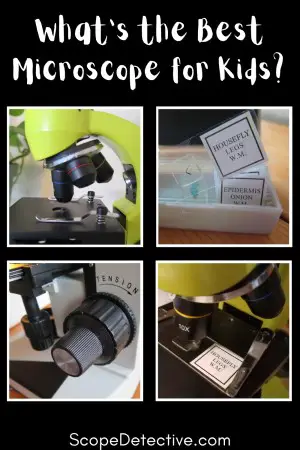 I’ve reviewed 10 microscopes in this article. But when it comes down to it, I recommend these three microscopes for kids and students:
I’ve reviewed 10 microscopes in this article. But when it comes down to it, I recommend these three microscopes for kids and students:
- The Celestron S10-60 – for kids 6 and under
- The Levenhuk Rainbow 50L PLUS – for kids ages 7 – 11
- The AmScope T490B – for students ages 12 and up
If you want a microscope for college biology, check this review of college microscopes.
Personally, I bought the Levenhuk Rainbow 50L and the Amscope T490B. You can see unboxing pictures below.
What’s the Difference Between my 3 Top Picks?
The Celestron S10-60 (Best for Kids 6 and under) is a ‘stereo’ microscope designed to see specimens like flowers, feathers, leaves and rocks. Younger children want to pick up, touch and play with their specimen, so this type of microscope (what we call a ‘stereo microscope’) is best for younger children.
> Jump to my Levenhuk 5ST review
The Levenhuk Rainbow 50L PLUS (Best for kids ages 7 – 11) is a ‘compound’ microscope designed to see bacteria and cells. It uses a monocular eyepiece which I find is better for younger children. It’s also got a simple uncomplicated design such as one focus knob (instead of your normal two), a simple rotating wheel light diaphragm, and a simple stage. It’s a good starter microscope for viewing specimens such as onion skins and sea monkeys.
> Jump to my Levenhuk Rainbow 50L review
The AmScope T490B (Best for students 12 and up) is a compound microscope that is a student’s first serious microscope. This microscope can be used for basic experimentation right up to college level projects like gram staining. It can follow a student right through their scientific career, but also isn’t overly expensive. It’s also great for photography.
> Jump to my AmScope T490B review
Best Microscopes Comparison Chart
| # | Microscope | Type | Magnification Range | Ocular Tubes | Stage | Price |
| 1. |
Celestron S10-60 |
Stereo | 10x – 60x | Binocular | Fixed | Check Here |
| 2. | Levenhuk Rainbow 50L Plus Best for Ages 7 to 11 |
Compound | 64x – 1280x | Monocular | Fixed | Check Here |
| 3. | Amscope T490B Best for Ages 12 and Up |
Compound | 40x – 2500x | Trinocular | Mechanical | Check Here |
| 4. | Amscope B120C | Compound | 40x – 2500x | Binocular | Mechanical | Check Here |
| 5. | AmScope M150C-MS | Compound | 40x – 1000x | Monocular | Mechanical | Check Here |
| 6. | National Geographic Microscope | Stereo | 20x – 50x | Binocular | Fixed | Check Here |
| 7. | Swift SW150 | Compound | 40x – 1000x | Monocular | Fixed | Check Here |
| 8. | Telmu 40X – 1000X | Compound | 40x – 1000x | Monocular | Fixed | Check Here |
| 9. | National Optical Microscope | Compound | 40x – 1000x | Binocular | Fixed | Check Here |
| 10. | Celestron 44121 | Compound | 40x – 600x | Monocular | Fixed | Check Here |
* I don’t recommend microscopes with cameras. Instead, I recommend buying a trinocular microscope then get a DSLR-to-microscope adapter for best quality images. See this discussion for how I take photos of specimens.
Best Microscopes for Students and Kids
1. Celestron S10-60 (for Ages 6 and Under)
Quick Review: This microscope is best for younger children who want to touch their specimens. It’s good for looking at coins, rocks, feathers, leaves and jewelry but not bacteria or cells.
Type: Stereo | Head: Binocular | Best for: Children 6 and Under | Magnification: 10x – 60x
The Celestron S10-60 is a stereo microscope. This means that it is great for looking at the finer features of insects, rocks, jewelry, coins and other visible specimens.
BUT!
It can’t look at bacteria and cells. For that, you’d need a compound microscope, such as the Levenhuk Rainbow 50L PLUS which I review next (scroll down!).
Very young children tend to prefer stereo microscopes because they’re like big magnifying glasses. In my experience younger kids are more inspired by seeing the eyes of a bug or the hairs on its legs than cell structures or round bits of bacteria.
And of all the affordable stereo microscopes on the market today, the Celestron S10-60 is my preferred model. The four magnification options makes it a big step up from competitors, who regularly just offer two.
For example, the competing National Geographic microscope only offers 20x and 40x while this model offers 10x, 20x, 40x and 60x. This provides you a ton of different magnification levels to get the perfect angle on your specimens.
The other great feature that’s notable and makes it stand out from competitors is the lighting. With above and below-stage lighting, as well as black and white background plates, this microscope provides you with the freedom to experiment with different light and background setting until you get the setting that’s perfect for you.
Lastly, this microscope offers a great experiment kit with 4x specimens out of the box to look at. Once you’re done exploring those four, go for a walk and find some cool rocks for your kids to experiment with!
2. Levenhuk Rainbow 50L PLUS (for Ages 7 – 11)
Quick Review: The Levenhuk Rainbow 50L PLUS is my preferred microscope for younger children. It’s got a simple build and design and attractive colors. It’s very easy to use and comes with a good experiment kit. You can see me doing all of the experiments from the included hit here.
Type: Compound | Head: Monocular | Best for: Kids Age 7 – 11 | Magnification: 64x – 1280x
There are a lot of very bad kids’ microscopes out there, even from the top brands. You need to look out for optical lens quality and lighting setup as key signs. Some cheaper microscopes are lit by a simple mirror, for example, which significantly decreases the quality of your images.
In my opinion, the Levenhuk Rainbow 50L PLUS does a decent job of providing quality in the most important parts – including the objective and eyepieces. The 40x objective is spring-loaded to provide protection if you accidentally tap it against the slide, which is not common for entry-level microscopes.
Your can achieve 64x – 1280x magnification with this microscope. You’ll find you’re usually using the 320x and 640x magnification levels for best quality when looking at cells and bacteria. This means that the provided Barlow lens is rarely used (in fact, I think I tried it out once and decided it wasn’t necessary).
Here’s a photo of it new out of the box:
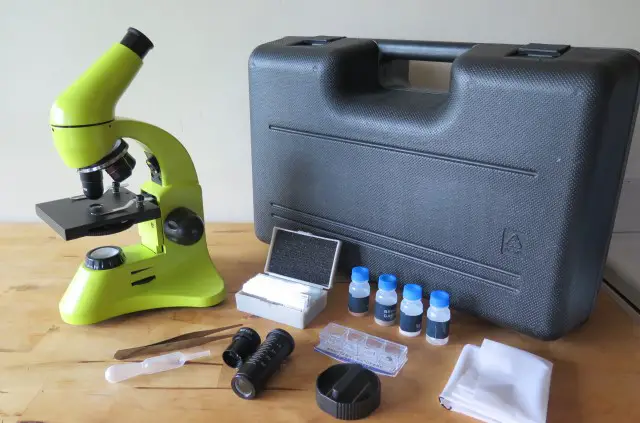
This microscope is designed with simplicity in mind. For intermediate to advanced users, this might get frustrating. You don’t get an iris diaphragm (instead you get a wheel with set apertures), and you also only have a coarse focus knob. I understand this was a decision for simplicity (which makes sense for beginners), but as a more advanced user I did miss the fine focus knob for perfecting focus at higher magnification ranges.
Similarly, I missed my binocular lenses (this only has monocular lenses, which are usually better for students to be fair because they’re less fiddly) and mechanical stage – but again, for cheaper entry-level microscopes you’ll never get any of those features.
I really liked the educational kit included with this model. The book (“Attractive Microscope. Scrutinizing the Microcosm”) is impressively detailed compared to the books provided by other entry-level kits. The included brine shrimp (aka sea-monkeys) experiment and prepared slides allow for some fun experiments out of the box.
Here’s a photo of that educational kit out of the box:
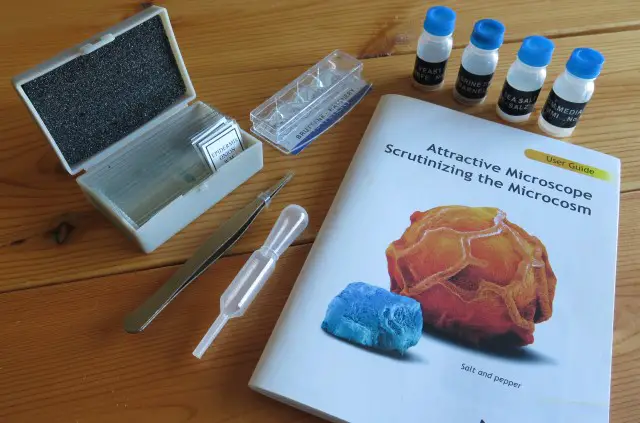
Oh, and you can choose your color at checkout which many kids would love.
So overall, of the cheaper entry-level microscopes for kids (with educational kits included), I do think the Levenhuk Rainbox 50L PLUS blows most others out of the water. But if you’re into more advanced experiments (or hope to be soon), chances are you’ll want to step up to the AmScope T490B pretty fast.
3. Amscope T490B – Best Microscope for Students Ages 12 and Up
Quick Review: I believe this is the best home-use microscope on the market today. It’s high quality but also affordable. You can use it for basic projects like viewing onion cells all the way up to advanced oil immersion methods. It is a real workhorse and is also my own personal microscope! I’ve been very happy with it.
Type: Compound | Head: Trinocular | Best for: Older Students & Photography | Magnification: 40x – 2500x
After researching a lot (A LOT!) of microscopes, this is the one I chose as the best microscope overall. I bought it about a year ago and absolutely love it. I use it as my main microscope.
This is the microscope you’d get if you want to get one microscope and never buy another one again. It’s good for everything from a kid’s microscope experiment all the way up to a college biology project.
The main differentiating factor between the T490B and others – such as the Amscope B120C reviewed below – is the third ocular tube sticking out the top. This tube makes photography easy. You can attach either a DSLR camera (with an adapter) or USB microscope camera to this port. Here’s mine with my DSLR camera attached for photography:

There’s also a comfortable viewing experience with this microscope compared to entry-level models thanks to the Siedentopf style head. This is a type of microscope head that doesn’t lose focus when you make interpupillary adjustments. In simple words – it feels and performs just like a pair of binoculars.
You’ll also have way better focus control thanks to the fine and coarse focus knobs (notice that the Levenhuk Rainbow models only have one focus knob). This extra focus control makes it easier to get a really clear view of your specimens.
Another feature that helps improve your view is the condenser setup on this model. It features an industry standard NA 1.25 Abbe condenser with an iris diaphragm. You’ll notice that beginner models only have disc diaphragms and simple lights without condensers. So, this lighting setup will give you more control over what you see and can help you control the brightness much more.
Lastly (and really importantly!) is the mechanical stage. This allows you to move the stage on the X-Y axis. This means you can scan your specimen without physically moving the slide with your fingers. Trust me – this ability to scan your slide using the knobs rater than your fingers is a HUGE user experience feature because it makes it easier to find what you’re looking for on the slide.
4. AmScope B120C
Quick Review: The Amscope B120C is a great little binocular microscope that’s competitive with the Amscope T490C, except it doesn’t have the trinocular head. If you are sure you won’t want to take detailed quality photos of your specimens, this one might be your top alternative to the T490C above.
Type: Compound | Head: Binocular | Best for: Value for Money | Magnification: 40x – 2500x
The Amscope B120C is a great workhorse microscope that I’d recommend if you were adamant you didn’t need the trinocular port of the T490B above. It’s a huge step up in quality compared to entry level models, and allows you to do everything you’d be able to do with the T490B, except for the photography port.
The steps up from basic models include a nice industry standard 1.25 NA Abbe Condenser with iris diaphragm, giving improved freedom to adjust the lighting effects, and giving better contrast overall.
There’s also a mechanical stage for scanning your specimen which is so nice for user experience. At higher magnification, you’ll often find the element of the slide you want to see is a little off center, so you can use the mechanical stage to move the piece you want to view to the center of your viewfinder.
And there’s also a Siedentopf binocular head which personally I find much more comfortable than monocular head microscopes. Siedentopf heads allow you to adjust the interpupillary distance without losing focus, much like on binoculars.
The total magnification for this model is 40x – 2500x. That 2500x magnification will be rarely used, though, because I usually find 600x – 1000x to be optimal for viewing most household specimens.
Most people working in 2000x – 2500x are going to be using oil immersion methods, and fortunately the 100xs objective on this model is designed for oil immersion (you even get an oil sample in the box) so you can get started on those more advanced brightfield methods out of the box.
For those interested in dabbling in phase contrast and darkfield methods, you can swap out the objectives and condenser for aftermarket add-ons, allowing this microscope to grow with your scientific curiosity.
Overall, the Amscope B120C is a nice affordable alternative to the T490B. It’s a really versatile workhorse in a nice sturdy build. I’d recommend it for anyone from middle school all the way up to university-level biology.
5. AmScope M150C-MS
Quick Review: I really like the M150C-MS because it’s the cheapest microscope I found with a mechanical stage. If you can’t justify the cost of the B120C, this one might be worth a look. Don’t forget you would need the -MS model to get the mechanical stage.
Type: Compound | Head: Monocular | Best for: Ages 7 – 11 | Magnification: 40x – 1000x | Top Feature: Mechanical Stage
The AmScope M150C-MS is a very nice microscope and I was teetering on the edge of buying this model, but decided against it.
I particularly like the mechanical stage. There are very few microscopes for kids that have a mechanical stage. The reason I love mechanical stages is they dramatically improve user experience. You can scan the specimen if it’s not quite in the center of the focus rather than manually trying to move the slide 1mm to the left or right.
On top of this, the AmScope M150C-MS also has nice features for a beginner microscope, such as a fine and coarse focus knob and a simple rotating disc aperture control (which is good for kids, but as they grow I’d prefer to go for an iris diaphragm).
6. National Geographic 20x – 50x Stereo Microscope
Quick Review: This stereo microscope has one of the best experiment kits included in the box. Unfortunately it doesn’t offer the same versatility of magnification levels as the Celestron S10-60.
Type: Stereo | Head: Monocular | Best for: Age 6 and Under | Magnification: 40x – 1000x
The National Geographic 40x – 1000x microscope carries the name of one of the best science brands on the planet. And consistent with the brand’s identity, this microscope is designed with the everyday beginner in mind.
This is a stereo microscope, meaning it’s designed for looking at objects like rocks, leaves and feathers rather than bacteria or cells. That’s good for younger kids who want to touch and feel everything!
There’s also a nice accessories kit included, which has shrimp eggs for growing your own sea monkeys.
Despite the glowing brand behind the microscope, it’s only got two magnification levels, and the magnification isn’t as high as many stereo microscopes on the market. I’d stick with the Levenhuk stereo microscope listed above and buy a stereo microscope experiment kit to go alongside it.
> Go to Full Review
7. Swift SW150
Quick Review: The Swift SW150 is a solid little microscope for elementary school children, but you’ll grow out of it fast and want to use one with more features from about age 12 and up.
Type: Compound | Head: Monocular | Best for: Ages 7 – 11 | Magnification: 40x – 1000x | Top Feature: Camera
The Swift SW150 is a good option for people who want a simple camera attached to their beginners microscope. There aren’t many entry-level compound microscopes that come with an included camera. Unfortunately, being entry-level, the camera isn’t the best. At 0.3 MP, you’re only going to get low resolution images from it.
Besides the camera, the microscope itself is about average for an entry-level model. It hasn’t got a mechanical stage, but does have appealing 1000x magnification and should allow you to do most beginner and even intermediate experiments with it.
I was a bit thrown by the need for an overhead light in this model – I don’t tend to expect (or want) overhead lights in compound microscopes.
But in general I think most people would be satisfied with this as a beginners-level compound microscope without any bells and whistles.
> Go to Full Review
8. Telmu 40x – 1000x
Quick Review: The Telmu 40x – 1000x is wildly popular, but I prefer to go with the big well-established brands like Amscope for my microscopes. The included cell phone adapter is a big appeal, though.
Type: Compound | Head: Monocular | Best for: Ages 7 – 11 | Magnification: 40x – 1000x | Top Feature: Cell Phone Adapter
The biggest appeal of this model is its affordability. It’s designed to be an affordable mass-market microscope for inspiring children’s scientific curiosity.
But I’m sure many people would also be drawn to the included cell phone adapter, which allows you to place your cell phone over the monocular eyepiece and record footage. This can be really fun to work with, but the footage is usually very poor. I tend to think of cell phone adapters on microscopes to be more gimmicky toys than anything. If you want a decent image, you’d want to get a 5MP microscope eyepiece camera or a DSLR to microscope adapter.
Overall, I’m sure most people would be satisfied with this microscope for light hobby microscopy, but people who really get into the hobby would start outgrowing it fast.
9. National Optical 40x – 1000x microscope
Quick Review: National Optical’s entry-level microscope provides all the basics you’d expect from an entry-level microscope but didn’t jump out at me with any additional features that made me want to buy it over the competition.
Type: Compound | Head: Monocular | Magnification: 40x – 1000x | Top Feature: Affordability
The National Optical 40x – 1000x microscope is ‘good enough’ but doesn’t boast any fantastic features that make me want to shout from the rooftops about it. It has what you’d expect: a basic non-mechanical stage, fine and coarse focus knobs, below stage light with dimmer and rotating disc aperture diaphragm.
I think most people would be satisfied with this as a basic kids’ microscope, but I also think there are better entry-level options out there. This one is a middling, normal old beginners microscope in my opinion.
The included prepared slides are nice, but without instruction cards or an educational walk through I think you’re still better off buying a microscope activity kit separately.
> Go to Full Review
10. Celestron 44121 Microscope Kit
Quick Review: The only reason you’d want to get this one is for the price tag. It’s really cheap, but also ranked 10th out of 10 in this round-up review!
Type: Compound | Head: Monocular | Best for: Throwaway Gift | Magnification: 40x – 600x
This microscope kit from Celeron is promoted as being for kids and beginners. Unfortunately this model does come across to me as more toy microscopes than ones I think can inspire scientific curiosity in a child.
This model has magnification of 40x – 600x which, to be fair, should achieve enough magnification to clearly view bacteria. But the overall microscope design appears to have had cost cutting in mind. The overhead pen light and below-stage are insufficient in my opinion for good enough light, especially at higher magnification levels. It looks to me like the stage comes from one of their other models, but the aperture disc has been removed.
Overall, I feel this microscope is more a toy than anything and I don’t feel it’d give sufficient magnification.
> Go to Full Review
Do you need a Microscope with a Camera?
When you first get started with microscopes, you’ll often want to take photos of your experiments to share what you saw. It’s that one final step in the project that brings so much joy.
I take pictures of all my specimens and share them here on my website. So I am adamant about making sure I have the ability to take pictures – and I think most people will end up wanting to take pictures sooner or later.
But there are a range of ways to take pictures of your specimens. The three main ones are:
1. Just hold a cell phone up to the eyepiece. This one’s free and still gets ok pictures, but not the quality that will blow anyone away. Here’s a picture of me demonstrating the process with my Levenhuk Rainbow 50L PLUS:
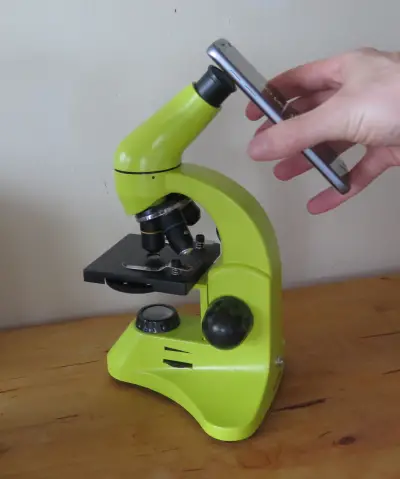
2. Buy a microscope USB camera. Personally I find the quality of these images disappointing and the price of the USB cameras too high to justify.
3. Buy a DSLR camera to Microscope adapter. This is what I did. If you’ve got a DSLR camera, I recommend it. Buy a trinocular microscope like the T490B and insert your DSLR camera into the photo port using an adapter like my CA-CAN-NIK-SLR adapter.
Here’s a picture of my Amscope T490B with my DSLR camera attached:

I talk about the three ways to take photos of your specimens on this page.
Final Thoughts
I hope this review has been helpful to you, and especially those images of my own microscopes from the top 3 suggestions. Overall, remember:
- Stereo microscopes are good for visible objects like rocks (which younger kids tend to enjoy).
- Compound microscopes are good for bacteria and cells.
- Consider whether you want to get a higher quality binocular model (like the Amscope T490B) for long-term scientific discovery, or a beginner model (like the Levenhuk Rainbow 50L), but remember for those who buy the beginner level model, you’d need to buy another one in 6 months if your microscopy hobby grows.
Thanks for reading and good luck with your microscopy!
Cheers,
Chris
Hi, I’m Chris and I run things around here! I share all my microscopy experiments, microscope information and tricks, how to guides, and microscope reviews in the articles on this site. Browse around to see what you like (I recommend the experiment ideas section) or connect with me on any of the social platforms listed below.
